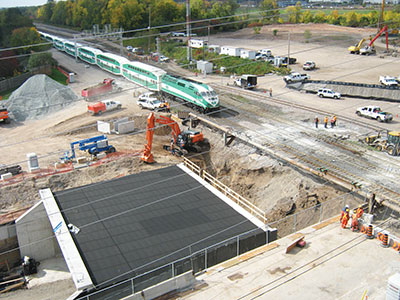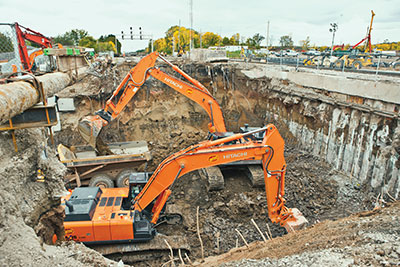
Features
Projects
Roads & Paving
The King Road Shuffle
From grade crossing to underpass in 72 hours.
July 25, 2013 By Harold wallace
A first-of-its-kind fast-track event involving three outstanding
Toronto-based contractors and a slew of Hitachi excavators took place
over Canada’s Thanksgiving weekend.
A first-of-its-kind fast-track event involving three outstanding Toronto-based contractors and a slew of Hitachi excavators took place over Canada’s Thanksgiving weekend.
 |
|
| Photos courtesy: John Deere
|
Over the course of three hectic October days, a very busy, four-track, railroad-grade crossing was transformed into a much safer roadway underpass. Called the King Road Grade Separation, the project was a joint venture between the City of Burlington, Ontario, and the Canadian National Railway (CNR). It was budgeted to cost C$24,515,000.
The big idea
Since CNR is the primary/almost-only east-west rail transportation across Canada, it was critical that disruptions of service be held to a minimum.
So the consulting team of Hatch Mott MacDonald and AMEC Earth and Environmental Consulting Engineers promoted four ideas in order to do as much work as possible before the Thanksgiving weekend.
First, divert all possible electrical, telephone and drainage services while not disturbing the rail- or roadways. Second, excavate an area beside the railway, in line with the ultimate underpass and parallel to the existing roadway. Third, build the new roadway as far as possible, short of the actual underpass. And fourth, pre-build the concrete underpass structure, slide it into place under the railway route at the appropriate time, then immediately reinstall the tracks.
“The scope of our project,” explains Ennio Liorti, president of Metric Contracting Services Corporation, “was to remove the rail track, excavate approximately 8,000 cubic metres (10,464 cubic yards), and build the concrete pads for the underpass bridge to slide into place. Another company did the actual jacking of the structure. And once it was in place, we did the backfilling and CNR reinstalled the tracks.”
Sounds straightforward enough, but the contract included a multitude of restrictions and a very real-time deadline. Start time was 11:59 Friday night, and it all had to be finished by 11:59 Monday night in order to handle the first roar of the early trains. The result was a very intensive 72 hours.
What does it take to move a five-million-pound bridge?
The concrete underpass Dufferin Construction constructed weighed 2,395,008 kilograms (5,280,000 pounds) and had to be moved 27 metres (90 feet) to be precisely placed not only under the railway but also in line with the new roadway. The way it was moved was amazing to watch. An incredible amount of work had to be completed within a 72-hour period that included the bridge move.
 |
|
| Excavation under the railway and all construction had to be done over a long holiday weekend.
|
Metric operators used their ZX350LC-5 with a special attachment to lift the existing rail-track sections one by one – with the wood ties in place – in a numbered sequence. They then trolleyed them back to a secure location, keeping them in the proper order. At the same time, other Metric-owned Hitachi excavators began digging away at the edges of the railway. The spoil was hauled to a nearby spot by their articulated trucks for reuse in the backfilling effort.
“We were notified about three weeks before the project start date that we had won the bid for our part,” explains Liorti. “So, within those three weeks, we needed to assemble about 25 pieces of equipment and organize 30 employees per shift – divided between operators, laborers and truck drivers – for a total of about 60 people. We could divert most of our equipment needs from other jobs for the long weekend, but we did rent a couple of wheel loaders.”
After the excavation was completed in the late afternoon hours of Saturday, the trolley pads were set up and poured. They had to be extremely level, and holes had to be precisely placed for use by hydraulic jacks that would help move the underpass. “Another company, Western Hydraulics, had the bid for actually moving the structure. Our goal was to provide the level pad for it to move on and the correct bore holes for their machines to sink their pins for traction.”
Using hydraulic jacks, with high-pressure air nozzled to the bottom of each square metre of the bridge, the transport company worked to raise the structure a few millimeters. Grease was lavishly applied to the Metric pads.
And the structure rose
“We were excited about the execution of this,” says Liorti. “We laid the grease and then watched the structure move into position. It was both amazing to see and a real comfort to realize the plans were being executed as expected.”
On schedule, the Dufferin-built structure moved without mishap, taking nearly five hours to be pushed into place by twin hydraulic rams controlled by remote joysticks.
“After the structure was in place, which again was an amazing feat, we backfilled the bridge structure and then CNR re-laid the tracks we had removed.”
Why Metric?
Metric has become an industry leader in excavating, grading and site preparation through its aggressive attention to the details of highly competitive bidding, project follow-through, well-trained employees, and a well-maintained and current equipment fleet.
“Our work is focused on heavy earthmoving and underground services in southern Ontario,” explains Liorti.“Recently, we’ve been involved with a number of hospital startups by providing their initial site preparation. We’ve also been a part of multiple earthmoving projects for the Ontario provincial government as new roads and bypasses have been developed. Right now, we’re working in downtown Toronto, providing specialized earthmoving work as the city prepares new buildings for the 2015 Pan-American Games.”
And Hitachi excavators?
“We bought our first Hitachi in ’87, just nine years after we started,” says Liorti. “And we’ve had 16 or 18 Hitachi excavators since then. Just prior to the King Road job, we purchased eight — and I think five of those new ones were on that job. We’ve always had great success with the Hitachi brand.
“Since the very beginning, Hitachi has always been a very good machine. We like owning Hitachi excavators, and the Wajax branch in Mississauga has done a good job supporting us.”
Metric Contracting Services Corporation is serviced by Wajax Equipment, Mississauga, Ont.
Print this page